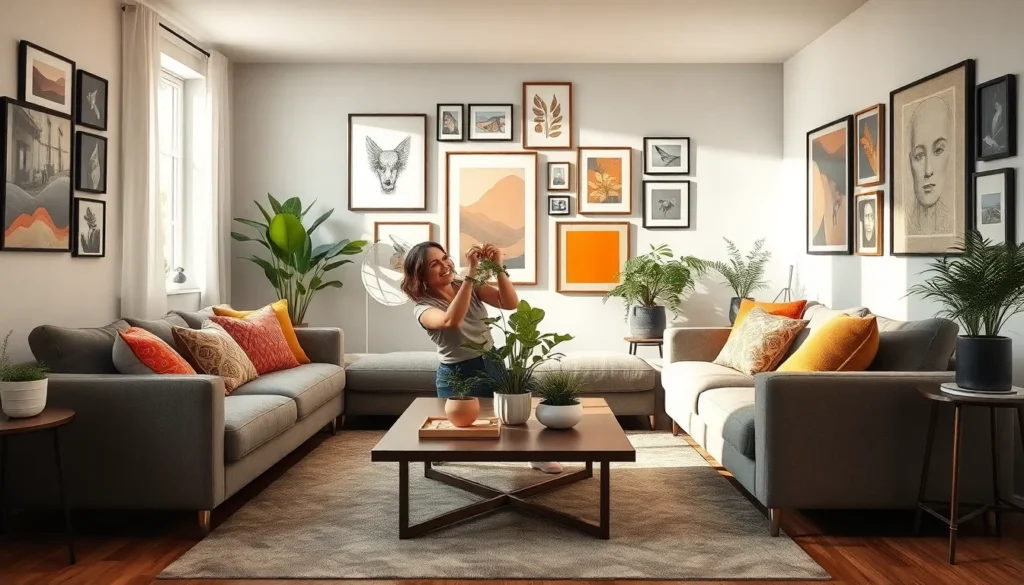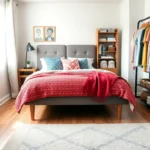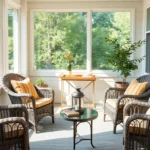We all know that feeling when we walk into a beautifully designed living room – it instantly captures our attention and makes us want to stay awhile. The living room serves as the heart of our homes where we entertain guests, relax after long days, and create lasting memories with family. That’s why getting the interior design just right is so important.
Creating a stunning living room doesn’t require a massive budget or professional designer. With the right ideas and approach, we can transform any space into a stylish and functional area that reflects our personality. Whether we’re working with a cozy apartment or spacious family room, smart design choices can maximize our space and enhance our daily living experience.
From choosing the perfect color palette to arranging furniture for optimal flow, we’ll explore practical interior design answers that make a real difference. These proven strategies will help us create a living room that’s both beautiful and livable.
Create a Cohesive Color Palette for Your Living Room
Color selection forms the foundation of successful living room design. We’ll explore proven strategies that help you develop a harmonious color scheme that enhances your space’s overall appeal.
Choose a Neutral Base with Bold Accent Colors
Neutral colors provide the perfect backdrop for creating sophisticated living room interiors. We recommend starting with timeless neutrals like warm whites, soft grays, or creamy beiges for your walls and larger furniture pieces. These versatile shades create a calming atmosphere while offering flexibility for future design changes.
Bold accent colors inject personality and visual interest into your neutral foundation. Consider incorporating vibrant hues through throw pillows, artwork, or decorative accessories. Rich jewel tones like emerald green, sapphire blue, or deep burgundy work beautifully against neutral backgrounds. Warmer accent colors such as burnt orange, golden yellow, or coral pink can energize your space and create inviting focal points.
Strategic placement of accent colors prevents overwhelming your living room design. Focus on distributing these vibrant elements across different areas of the room rather than clustering them in one spot. This approach ensures your eye moves naturally throughout the space while maintaining visual balance.
Use the 60-30-10 Rule for Color Distribution
The 60-30-10 rule provides a foolproof formula for balanced color distribution in living room spaces. This interior design principle allocates 60% of your color palette to a dominant neutral shade, 30% to a secondary color, and 10% to accent colors.
Dominant colors typically cover your walls, large furniture pieces, and major textiles like area rugs or curtains. Secondary colors appear in medium sized elements such as upholstered chairs, coffee tables, or decorative lighting fixtures. Accent colors shine through smaller accessories like throw pillows, vases, or artwork.
We’ve found this distribution creates visual harmony while preventing any single color from overpowering your living room design. Start by selecting your dominant neutral, then choose a complementary secondary color that appears in roughly one third of your decorative elements. Finally, add your accent color sparingly through carefully chosen accessories that draw the eye and create focal points.
Consider Natural Light When Selecting Colors
Natural light significantly impacts how colors appear in your living room throughout the day. We recommend observing your space at different times before making final color decisions. North facing rooms receive cooler, more consistent light that can make colors appear slightly muted. South facing living rooms enjoy warm, bright light that intensifies color saturation.
Morning light tends to cast cooler tones, while afternoon and evening light appears warmer and more golden. Test your chosen colors by placing large paint samples or fabric swatches in various areas of your room. Observe how these colors change from morning to evening to ensure you’re satisfied with their appearance in all lighting conditions.
Artificial lighting also affects your color palette’s appearance. Warm LED bulbs enhance reds, oranges, and yellows while potentially dulling cooler blues and greens. Cool white lighting brings out blues and greens but may make warm colors appear less vibrant. Balance your lighting choices with your color selections to achieve the desired atmosphere in your living room design.
Maximize Your Living Room Layout and Space Planning
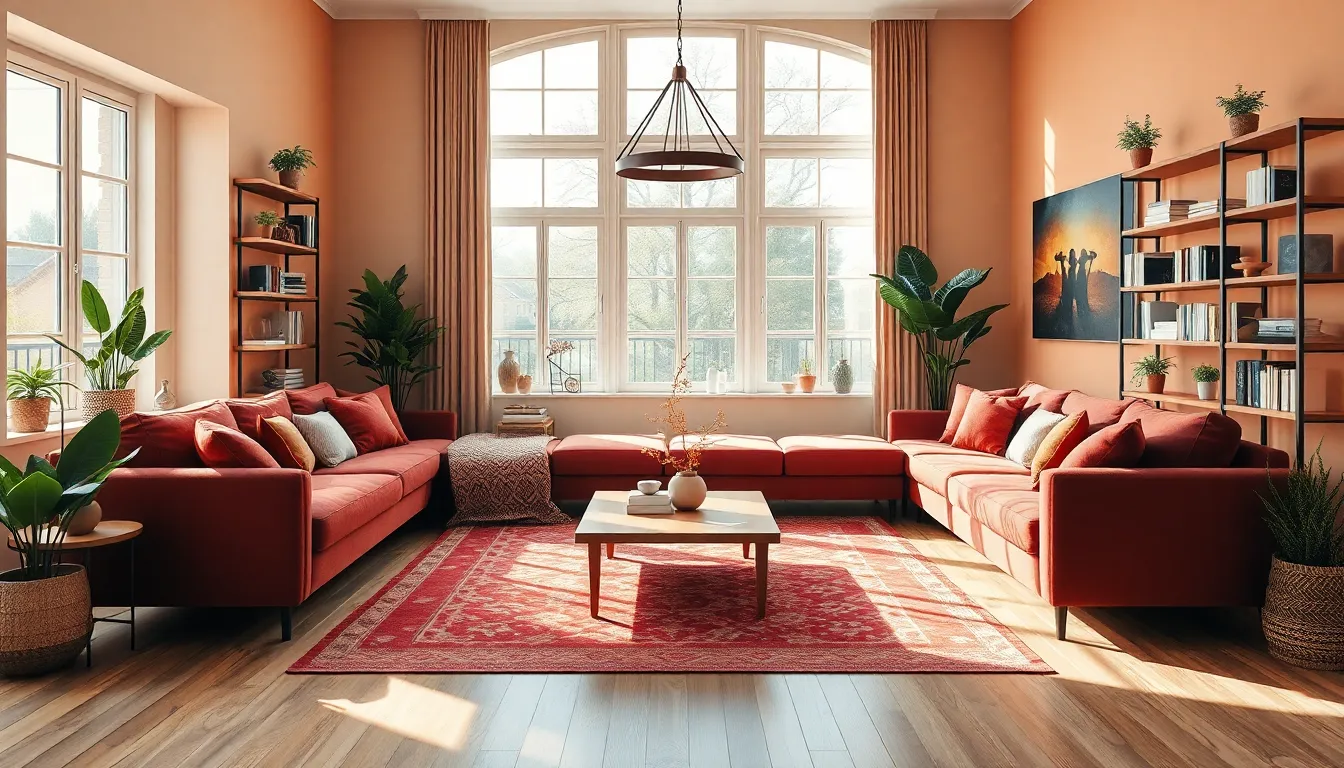
Thoughtful space planning transforms our living rooms into functional havens that serve multiple purposes while maintaining visual appeal. We’ll create zones for conversation, entertainment, and relaxation by strategically positioning furniture and utilizing every square foot effectively.
Arrange Furniture to Promote Conversation
Grouping seating in a U-shape or around a central coffee table encourages natural interaction between family and guests. We position sofas and chairs so everyone has a clear view of each other, creating an intimate atmosphere that draws people together. Placing large pieces like media units against walls opens up the center space for conversation areas, preventing furniture from becoming barriers to communication.
Our seating arrangement should ensure that no one feels left out of discussions. We avoid positioning chairs with their backs to the room’s entrance, as this creates an unwelcoming feeling for newcomers. Consider keeping focal points like fireplaces or artwork visible from all seating positions to give conversations natural starting points.
Create Clear Pathways Through the Room
Maintaining at least 36 inches for main walkways ensures comfortable movement throughout our living spaces. We allow 24 inches for secondary paths between furniture pieces, giving people enough room to navigate without feeling cramped or knocking into obstacles.
Positioning furniture thoughtfully means avoiding large items in high traffic zones where people naturally walk. We keep pathways free from ottomans, side tables, or decorative objects that could create tripping hazards. Nothing should obstruct doors or windows, as this blocks natural light and makes the room feel closed off.
Use Vertical Space for Storage and Decor
Installing shelves and cabinets on wall space keeps books, decor, and media equipment organized while maintaining clutter free surfaces. We use the area above eye level for items we don’t access daily, such as seasonal decorations or photo albums.
Adding wall art through tall plants, framed prints, or mirrors draws the eye upward and makes our rooms appear larger than their actual dimensions. Vertical elements create visual interest without consuming valuable floor space that we need for movement and furniture placement.
Consider pendant lights or wall mounted fixtures instead of table lamps to free up surface area on side tables and consoles. We can also install floating shelves at varying heights to create ever-changing storage answers that double as decorative displays.
Select the Perfect Furniture Pieces for Style and Function
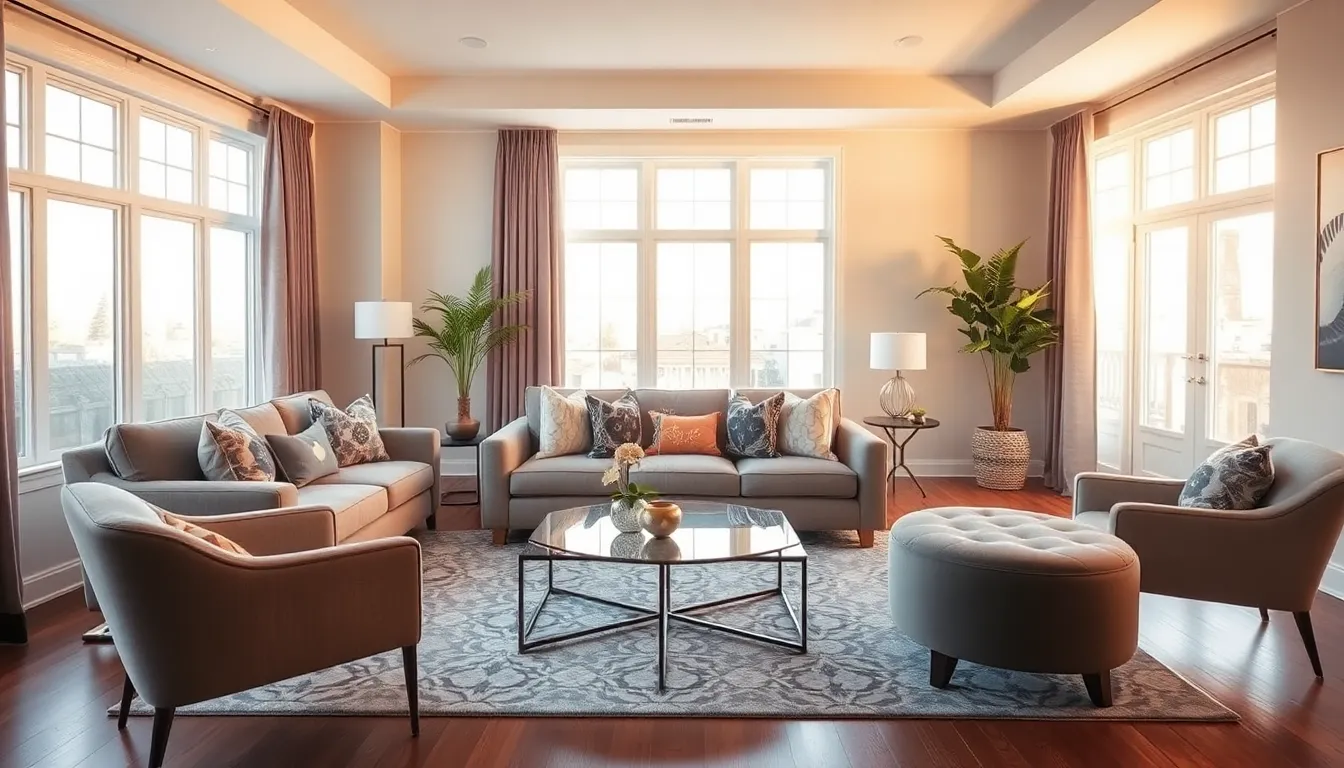
Choosing the right furniture transforms your living room from an empty space into a stylish and functional haven. We’ll explore three essential furniture categories that create the perfect balance of comfort and design.
Invest in a Statement Sofa as Your Focal Point
Statement sofas serve as the centerpiece of your living room design. We recommend selecting a piece that combines visual appeal with everyday comfort while reflecting your personal style preferences. Consider how the sofa’s design complements your room’s overall aesthetic and meets your family’s daily needs.
Sectional sofas work exceptionally well in larger spaces. These expansive pieces provide ample seating for gatherings while creating an intimate, cozy atmosphere that encourages conversation. Position your sectional to define the main seating area and establish clear sight lines throughout the room.
Material selection impacts both durability and style. Choose fabrics like performance textiles for high-traffic homes or luxurious velvet for formal spaces. Leather options offer timeless appeal and easy maintenance for busy households.
Choose Coffee Tables That Match Your Lifestyle
Coffee table placement requires precise spacing for optimal functionality. We suggest positioning your coffee table approximately 18 inches from your sofa to ensure comfortable legroom while maintaining easy access for drinks and books. This distance promotes natural conversation flow among guests.
Style coordination creates visual harmony throughout your space. Select coffee tables that complement your sofa and other furniture pieces through matching materials, finishes, or design elements. Wood tables pair beautifully with leather sofas, while glass options lighten spaces with dark upholstery.
Functionality should guide your coffee table selection. Consider tables with built-in storage for magazines and remote controls, or choose nesting tables that can be separated when you need extra surface space for entertaining.
Add Versatile Seating Options for Entertaining
Armchairs enhance both comfort and conversational dynamics. We position these pieces in room corners or facing the main sofa to create intimate conversation circles that encourage guest interaction. Choose styles that complement your sofa without exactly matching for added visual interest.
Ottomans provide flexible seating and storage answers. These versatile pieces serve as extra seating during parties, footrests for relaxation, and hidden storage for throws and games. Select ottomans that can easily move around your space as needs change.
Accent chairs introduce personality and additional functionality. Place these statement pieces strategically to fill empty corners while providing comfortable seating options for reading or conversation. Choose bold colors or patterns that complement your overall color scheme while adding visual excitement to the room.
Layer Different Types of Lighting for Ambiance
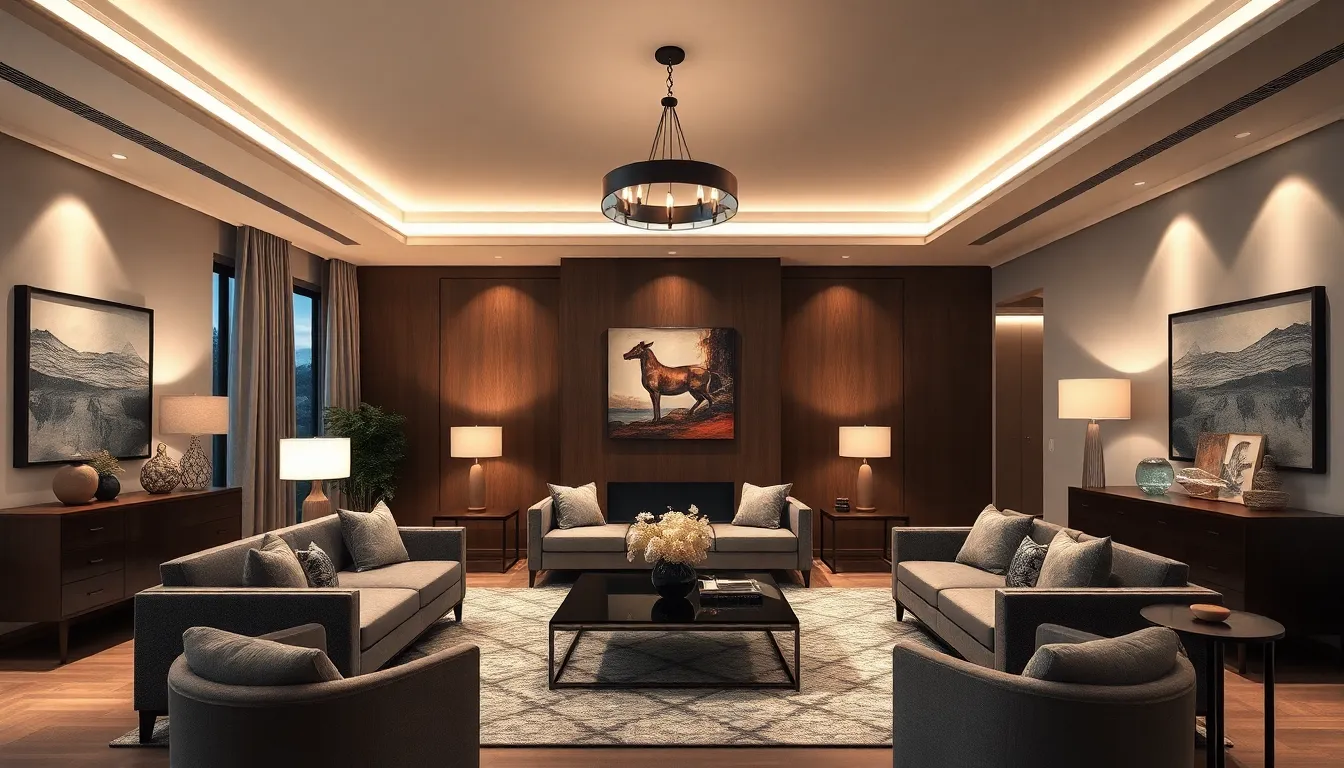
We’ve covered color schemes and furniture selection, but proper lighting design transforms our living room into a truly inviting space. Strategic layering of multiple light sources creates depth and flexibility that single fixtures simply can’t achieve.
Install Overhead Lighting for General Illumination
Ceiling fixtures serve as the foundation of our lighting design by providing essential overall illumination throughout the space. Track lights offer versatile positioning options that allow us to direct light where it’s needed most while maintaining a modern aesthetic. Dimmable LED lights give us complete control over brightness levels, making it easy to adjust the atmosphere from bright task lighting to cozy evening ambiance.
Central pendant lights work beautifully in rooms with higher ceilings, creating a focal point while distributing light evenly across seating areas. Recessed lighting provides clean, unobtrusive illumination that doesn’t compete with our décor choices. Flush mount fixtures suit lower ceilings perfectly and come in styles that complement everything from contemporary to traditional design themes.
Add Table and Floor Lamps for Task Lighting
Table lamps positioned on side tables or console surfaces provide focused illumination for reading, working, or other detailed activities. Floor lamps fill empty corners while offering adjustable lighting that’s perfect for exact tasks like crafting or checking our phones. These portable fixtures also serve as decorative elements that enhance our room’s overall design aesthetic.
Swing arm lamps mount to walls beside seating areas, saving valuable surface space while providing targeted light exactly where we need it. Desk lamps on console tables create functional workspaces within our living areas. Multiple task lighting sources throughout the room ensure we’ll never struggle with poor visibility during activities that require focused attention.
Use Accent Lighting to Highlight Architectural Features
Spotlights draw attention to artwork, architectural details, or decorative collections that showcase our personal style. Under cabinet lighting illuminates built in shelving while creating dramatic shadows that add visual depth to our space. Wall sconces flanking fireplaces or mounted beside mirrors provide subtle illumination that enhances these focal points.
Picture lights mounted above artwork ensure our favorite pieces receive proper illumination while creating gallery worthy displays. Strip lighting behind furniture or along baseboards adds contemporary flair while providing soft ambient glow. These accent pieces work together to create visual interest and highlight the architectural elements that make our living room unique.
Incorporate Textures and Patterns for Visual Interest

We can transform our living room from bland to beautiful by strategically layering textures and patterns that create depth and visual appeal. This design approach adds personality and warmth without requiring major renovations or expensive furniture replacements.
Mix Different Fabric Textures on Pillows and Throws
Mixing fabric textures creates an inviting tactile experience that draws people into our living space. We should combine smooth velvet pillows with chunky knitted throws to establish contrast and visual depth. Linen cushions paired with silk accents offer another sophisticated combination that feels both casual and elegant.
Layering different textures works best when we stick to a cohesive color scheme while varying the materials. Rough jute fabrics complement soft cotton throws beautifully, while metallic accents on pillows can add glamour to natural fiber pieces. We can achieve maximum impact by grouping odd numbers of textured items together, such as three throw pillows with different surface treatments on our main seating area.
Combine Various Patterns Without Overwhelming the Space
Combining patterns successfully requires following the three pattern rule to maintain visual harmony. We should limit ourselves to stripes, florals, and geometrics that share at least one common color from our established palette. This approach prevents our living room from feeling chaotic while still creating interesting focal points.
Scale variation becomes crucial when mixing patterns effectively in our design scheme. Large scale patterns work best as dominant elements on major pieces like area rugs or curtains, while medium patterns suit throw pillows and smaller accent pieces. Small scale patterns fill in gaps and provide subtle texture without competing for attention with our statement pieces.
Pattern coordination works when we maintain consistent color temperatures throughout our selections. Warm toned patterns should stay together, just as cool toned combinations create their own cohesive grouping that feels intentional rather than accidental.
Add Natural Elements Like Wood and Stone
Natural elements like wood and stone instantly enhance the warmth and coziness of our living room environment. Wooden furniture pieces or accent walls create organic texture that softens modern spaces, while stone fireplaces or feature walls add architectural interest and grounding weight to our design.
Biophilic design principles help us connect with nature through living walls, natural light optimization, and organic material choices in our furniture selections. Plants become living texture elements that change seasonally and provide air purification benefits alongside their aesthetic contribution to our space.
Wood grain patterns offer natural texture variation that complements both smooth and rough fabric choices in our seating arrangements. Stone surfaces provide cool contrast to warm textile layers, creating temperature balance that makes our living room feel more comfortable and inviting throughout different seasons.
Style Your Walls with Art and Decorative Elements
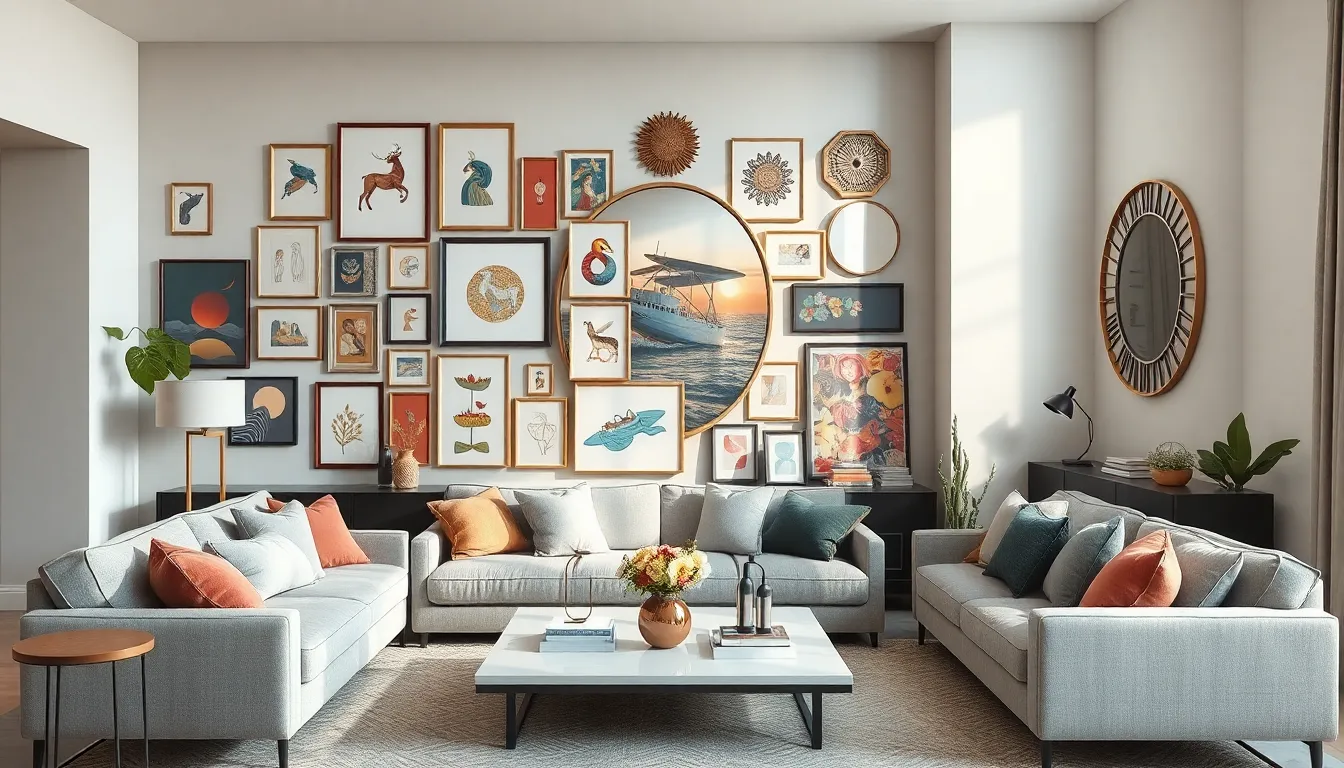
Walls offer endless opportunities to transform your living room into a personalized sanctuary that reflects your unique style. Modern living rooms in 2025 increasingly rely on artwork and decorative elements to serve as focal points while showcasing the homeowner’s personality.
Create Gallery Walls That Reflect Your Personality
Gallery walls have become a standout trend for adding character and warmth to living spaces through curated collections of art, photographs, and mixed media. We recommend starting with pieces that speak to your personal story, whether they’re family photos, travel memories, or artwork that resonates with your aesthetic vision.
Experimenting with different frame styles, sizes, and textures creates visual interest while maintaining cohesion throughout your arrangement. Mix vintage frames with modern ones, or combine black and white photography with colorful abstract pieces to achieve a ever-changing yet balanced look.
Planning your layout before hanging ensures the best results for your gallery wall composition. We suggest laying out your pieces on the floor first, measuring the wall space, and using paper templates to visualize the arrangement before committing to nail holes.
Spacing between frames should remain consistent, typically 2-3 inches apart, to create a polished appearance that draws the eye across the entire collection. Start with your largest piece as an anchor, then build around it with smaller complementary works.
Use Mirrors to Enhance Light and Space
Mirrors strategically placed throughout your living room can visually expand the space while improving both natural and artificial light sources. These reflective surfaces make rooms appear larger and brighter, which proves especially beneficial for smaller living areas where maximizing space is essential.
Positioning mirrors opposite windows amplifies natural daylight, creating a brighter atmosphere throughout the day while reducing the need for additional lighting. Large statement mirrors work particularly well above sofas or mantels, serving as both functional pieces and decorative focal points.
Grouping smaller mirrors together creates an interesting alternative to traditional gallery walls while still achieving the light-improving benefits. We recommend varying the shapes and frame styles within your mirror collection to add visual texture and prevent monotony.
Consider the reflection when placing mirrors, ensuring they capture and bounce light to areas that need illumination rather than reflecting cluttered spaces or unflattering angles.
Consider Statement Wallpaper or Paint Techniques
Statement wallpaper offers a bold way to personalize your living room without overwhelming the entire space when applied to a single accent wall. Bold patterns, rich textures, or unique designs can transform an ordinary room into a sophisticated space that reflects your style preferences.
Creative paint techniques provide versatile alternatives to wallpaper while offering endless customization possibilities for your living room walls. Color blocking creates distinct geometric sections, ombré techniques blend colors seamlessly from light to dark, and geometric patterns add modern visual interest.
Choosing the right wall for your statement treatment ensures maximum impact without creating visual chaos in your living space. We typically recommend the wall behind your main seating area or the one visible when entering the room as ideal candidates for bold treatments.
Balancing statement walls with neutral furnishings prevents the space from feeling overwhelming while allowing your wall treatment to shine as the room’s main attraction. Keep surrounding elements simple and cohesive to let your creative wall work take center stage.
Add Plants and Natural Elements for Life and Color
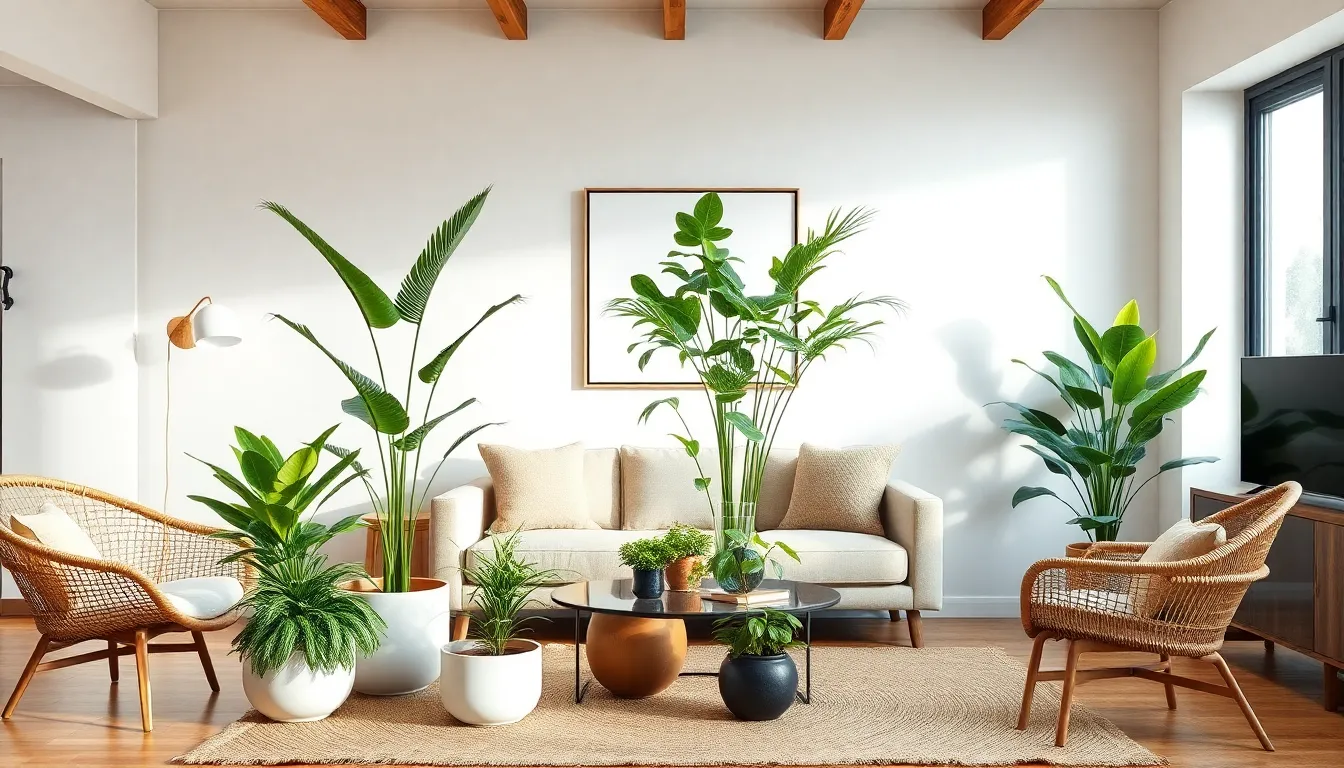
Incorporating plants and natural elements transforms our living room into a vibrant, health-conscious space that promotes well-being while improving visual appeal. These organic additions create focal points that complement our carefully planned color palette and lighting design.
Choose Low-Maintenance Indoor Plants for Beginners
Areca Palms serve as excellent starting points for plant enthusiasts, offering impressive height and tropical elegance while requiring minimal care. These adaptable plants thrive in medium, indirect sunlight and need watering only when the top inch of soil feels dry.
String of Pearls adds unique texture with its cascading beads of green spheres, making it perfect for shelves or hanging displays. This succulent stores water in its leaves and tolerates periods of neglect, making it ideal for busy lifestyles.
Umbrella Plants provide lush, tropical foliage that adapts to various lighting conditions throughout our living room. Their glossy leaves create natural air purification while requiring watering only when soil becomes slightly dry.
Pothos brings trailing beauty to high shelves or hanging planters, with heart-shaped leaves that thrive in low to bright indirect light. This versatile plant propagates easily in water, allowing us to create multiple displays from a single plant.
Use Planters That Complement Your Design Style
Modern living rooms benefit from sleek ceramic planters in geometric shapes or neutral tones that echo our color palette. Clean lines and minimalist designs prevent plant containers from competing with furniture and decor elements.
Rustic spaces call for natural wood planters or woven baskets that enhance the organic atmosphere we’ve created. These materials add warmth and texture while seamlessly blending with existing natural elements.
Bamboo planters offer sustainable elegance that works across multiple design styles, from contemporary to bohemian. Their natural grain patterns create visual interest while maintaining the clean aesthetic we desire.
Ceramic options provide versatility in colors and finishes, allowing us to match existing accent pieces or introduce new tones. Glazed surfaces reflect light beautifully, improving our carefully planned lighting scheme.
Incorporate Natural Materials Like Rattan and Jute
Rattan furniture introduces organic curves and textures that soften hard edges in our living room design. Side tables, storage baskets, and accent chairs in rattan create visual warmth while maintaining functionality.
Jute textiles bring earthy textures through area rugs, throw pillows, and wall hangings that ground our color scheme. These natural fibers add tactile interest while complementing the various textures we’ve already incorporated.
Wooden accents through plant stands, decorative bowls, and picture frames create cohesive natural elements throughout the space. Different wood tones add depth while maintaining the organic theme we’re establishing.
Stone vases provide striking contrast against soft textiles and living plants, creating balanced visual weight. These elements anchor our natural design while serving as sculptural focal points that enhance our overall aesthetic.
Organize and Display Personal Items Thoughtfully
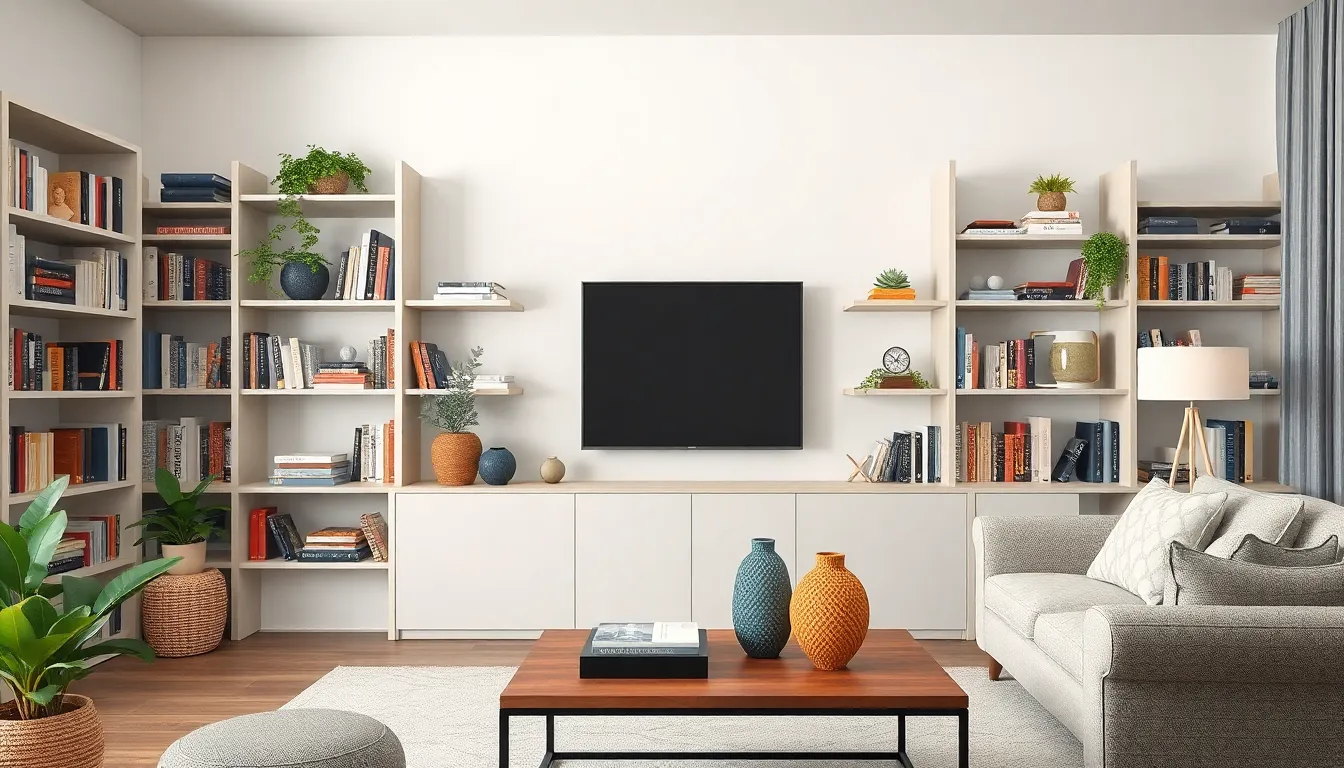
Thoughtful organization of personal items transforms our living rooms into spaces that truly reflect our personalities while maintaining visual harmony. Strategic placement of family photos, artwork, keepsadings, and collections creates meaningful displays that enhance both function and aesthetics.
Style Bookshelves with Books and Decorative Objects
Mix horizontal and vertical book arrangements to create visual movement throughout your shelving units. Stack some books horizontally while positioning others vertically, then intersperse sculptural items, framed photos, and greenery between the volumes for added texture and interest.
Incorporate objects of varying heights and materials such as ceramics, wood, or glass to add dimensional appeal. Different textures and scales prevent monotony while creating captivating focal points that draw the eye across each shelf level.
Maintain cohesive color schemes for a balanced, professional appearance that ties your display together. Group items by complementary hues or stick to a neutral palette with strategic pops of accent colors that match your room’s overall design.
Avoid overcrowding with too many small items by grouping similar objects on trays or within decorative bowls. This approach maintains a stylized appearance while preventing visual chaos that can overwhelm the space.
Create Vignettes on Side Tables and Mantels
Group three or five objects together to create compelling vignettes that define character on side tables and mantels. Odd numbers naturally create more visually pleasing arrangements than even groupings, following basic design principles.
Combine elements at different heights such as lamps, candles, small plants, or books to establish visual hierarchy. Varying elevations create depth and prevent flat, uninspiring displays that lack dimensional interest.
Use trays or stands to anchor arrangements while ensuring variety in scale and texture for a collected, layered effect. These foundational pieces help unify disparate objects while providing structure to your decorative groupings.
Leave ample negative space between objects to foster a sense of calm and order throughout your displays. Strategic spacing prevents overcrowding while allowing each piece to shine individually within the larger composition.
Hide Clutter with Stylish Storage Answers
Conceal everyday items with decorative boxes and lidded baskets to maintain visual appeal while keeping essentials within reach. Remote controls, charging cables, and seasonal decor disappear into attractive storage pieces that complement your design aesthetic.
Choose built-in cabinets for seamless integration that maximizes storage capacity without compromising style. Custom answers blend naturally with your room’s architecture while providing ample space for items you need but don’t want on display.
Balance open and hidden storage to prevent spaces from feeling overwhelmed by clutter while maintaining functional accessibility. Strategic combination of visible displays and concealed storage creates the perfect equilibrium between form and function.
Select storage pieces that match your room’s aesthetic for a seamless look that enhances rather than detracts from your overall design. Coordinated materials, colors, and styles ensure storage answers feel intentional rather than afterthoughts.
Choose Window Treatments That Enhance Your Design

Window treatments serve as the finishing touch that ties together your living room’s aesthetic while providing essential functionality. They can dramatically impact both the room’s ambiance and your daily comfort levels.
Select Curtains or Blinds That Frame Your Windows
Curtains and blinds should complement your room’s existing style while serving your exact needs. Start by determining whether you need blackout, sheer, or light-filtering options based on your living room’s purpose and desired atmosphere. Blackout treatments work well for spaces where you watch television or need complete darkness, while sheer options are perfect for maintaining an airy, open feeling.
Fabric selection plays a crucial role in achieving the right aesthetic match for your room’s style. We recommend choosing materials that echo your existing color palette and texture scheme. Proper fit is equally important to avoid overwhelming your space with treatments that are too large or leaving windows looking bare with options that are too small.
Consider Layering Different Window Covering Types
Layering creates depth and visual interest while maximizing your control over light and privacy. Combining Roman shades with panels adds both texture and functionality to your windows. This approach allows you to have the clean lines of shades when you want an unobstructed view and the softness of panels for a more formal appearance.
Top down bottom up shades offer exceptional versatility for living rooms. These treatments allow natural light to enter from the top while maintaining privacy at eye level by adjusting the shade’s position. They’re particularly effective for street-facing windows where you want brightness without sacrificing privacy.
Use Window Treatments to Control Light and Privacy
Natural light management becomes effortless with the right window treatment choices. Sheer drapes and solar shades maximize natural light in living areas while providing basic privacy during daytime hours. These options filter harsh sunlight while maintaining your connection to the outdoors.
Privacy requirements vary throughout the day and across different seasons. Blackout roller shades or layered treatments are ideal for spaces requiring more seclusion during evening hours or when you’re entertaining guests. Consider how your living room’s orientation affects light patterns and choose treatments that can adapt to changing conditions throughout the day.
Hanging curtains high on the wall or using recessed hardware creates the illusion of taller ceilings while improving your room’s overall elegance. This technique draws the eye upward and makes your living space feel more spacious and sophisticated.
Conclusion
Transforming your living room doesn’t have to be overwhelming or expensive. By implementing these design strategies—from establishing a cohesive color palette to layering lighting and incorporating natural elements—you can create a space that truly reflects your personality while serving your daily needs.
Remember that great interior design is about balance. Mix textures thoughtfully combine patterns strategically and display your personal items with intention. Each element should work together to create a harmonious environment where you and your guests feel comfortable and inspired.
Start with one or two changes that resonate most with your vision. Whether it’s rearranging your furniture layout adding plants for natural beauty or updating your window treatments the key is to make choices that enhance both function and style. Your living room should tell your story while providing the perfect backdrop for life’s everyday moments.
Frequently Asked Questions
What is the 60-30-10 color rule for living room design?
The 60-30-10 rule is a color distribution guideline that helps create balanced living room design. Use 60% of your palette for a dominant neutral color (like warm whites or soft grays), 30% for a secondary color, and 10% for bold accent colors through accessories like throw pillows, artwork, and decorative items.
How much space should I leave for walkways in my living room?
Maintain at least 36 inches of clearance for main walkways in your living room. This ensures comfortable movement throughout the space and prevents guests from having to navigate around furniture. Avoid placing furniture or decorations in high-traffic areas to keep pathways clear and functional.
What type of lighting should I use in my living room?
Layer three types of lighting for optimal results: overhead fixtures (track lights or pendants) for general illumination, task lighting (table and floor lamps) for focused activities like reading, and accent lighting (spotlights or wall sconces) to highlight architectural features and create visual interest.
Which plants are best for living room beginners?
Low-maintenance plants perfect for living room beginners include Areca Palms, String of Pearls, Umbrella Plants, and Pothos. These plants offer aesthetic appeal, air-purifying benefits, and require minimal care while adding natural elements that enhance your living space’s warmth and connection to nature.
How should I arrange seating to promote conversation?
Group seating in a U-shape or around a central coffee table to encourage interaction among guests. Ensure clear sightlines between all seating areas and maintain comfortable distances for conversation. Consider sectional sofas for larger spaces and add versatile seating like armchairs and ottomans for flexibility.
What’s the three-pattern rule for mixing patterns in living rooms?
The three-pattern rule helps you combine different patterns harmoniously without creating visual chaos. Choose three patterns that share at least one common color, varying their scales (large, medium, small) to create visual interest while maintaining cohesion throughout your living room design.
How high should I hang curtains to make my living room look taller?
Hang curtains high on the wall, close to the ceiling rather than just above the window frame. This technique creates the illusion of taller ceilings and makes your living room appear more spacious and elegant. Choose floor-length curtains for maximum visual impact.
What materials should I consider for a durable living room sofa?
Choose performance textiles or leather for durability and style in high-use living rooms. Performance fabrics resist stains and wear while maintaining their appearance, while leather develops character over time and is easy to clean. Both options combine visual appeal with practical functionality.

